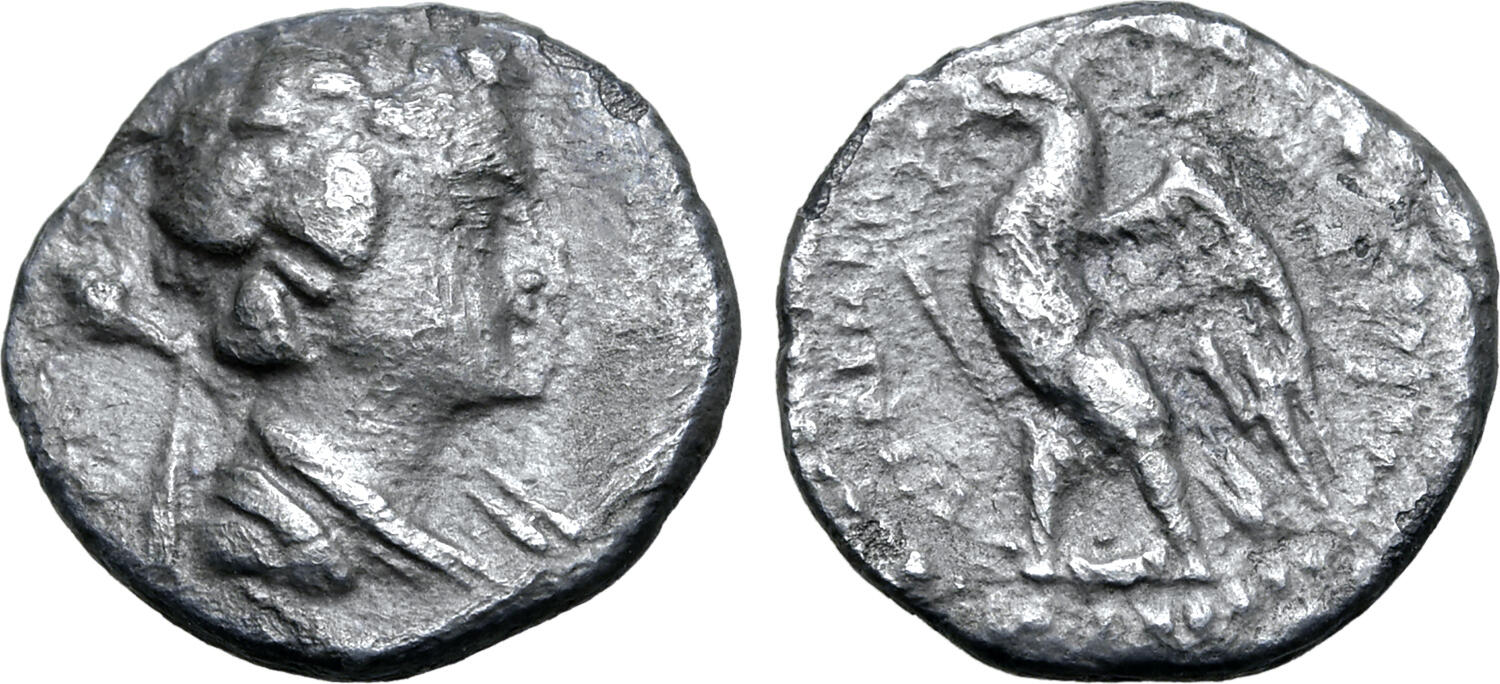Paphos (Ptolemies), silver, drachms (185-106 BCE)
From SILVER
185 BCE - 106 BCE Silver 775 kg
Description
| ObverseInscription or printing placed on the obverse.: | Bust of Dionysos to right, wearing vine wreath and thyrsus. |
| ReverseInscription or printing placed on the reverse.: | ΠΤΟΛΕΜΑΙΟΥ ΒΑΣΙΛΕΩΣ (Greek).Eagle standing left, wings open, on thunderbolt. (In field, KI or calathos). |
Mint and issuing power
| MintIdentifies the place of manufacture or issue of a numismatic object.: | Paphos | Ancient regionAncient region.: | Cyprus | Modern countryModern country: Greece | AuthorityIdentifies the issuing power. The authority can be "pretended" when the name or the portrait of X is on the coin but he/she was not the issuing power. It can also be "uncertain" when there is no mention of X on the coin but he/she was the issuing power according to the historical sources: | Ptolemaic dynasty (323-30 BC) |
Chronology
| FromIdentifies the initial date in a range assigned in a numismatic context. | 185 BCE | toIdentifies the final date in a range assigned in a numismatic context.. | 106 BCE | PeriodTime period of the numismatic object.: Hellenistic 323-30 BC |
Physical description
| MetalThe physical material (usually metal) from which an object is made.: | Silver |
Median weightMedian of the weights of numismatic objects (in grams). in grams | 3.20 | DenominationTerm indicating the value of a numismatic object. Examples: tetradrachm, chalkous, denarius.: | drachma |
StandardStandard.: | Ptolemaic |
Image

S637 Paphos drachms.jpg [1]
References
| Die study referencePublication of the study: | Olivier 20121Olivier 2012, p. 135, n° 2564-2571 and p. 140, n° 2650-2665. | ||
| Coin series referenceReference to coin series study: | Sear II2Sear II, n° 7875 | ||
Obverse dies distribution
| FrequencyFrequency of specimen in distribution. ᵖ | Number of obversesNumber of obverse dies. ᵖ (o) | % (o) | Number of coinsNumber of coins. (n) | % (n) | Die nameName(s) of the die(s). |
| 1 | 3 | 33.33 | 3 | 12.5 | 9, 10, 12 |
| 2 | 1 | 11.11 | 2 | 8.33 | 11 |
| 3 | 3 | 33.33 | 9 | 37.5 | 8, 57, 58 |
| 4 | 1 | 11.11 | 4 | 16.67 | 60 |
| 6 | 1 | 11.11 | 6 | 25 | 59 |
| Total | 9 of 9 | 99.99 | 24 of 24 | 100 |
Reverse dies distribution
no distribution is available
Quantification
| Number of obversesNumber of obverse dies. ᵖ (o) | 9 | Number of singletons (o1)The number of singleton coins. ᵖ | 3 |
| Number of reverse diesNumber of reverse dies. (r) | 18 | Number of coinsNumber of coins. (n) | 24 |
| Coins per obverse dieNumber of coins per obverse die. (n/o) | 2.67 | Coins per reverse dieNumber of coins per reverse die. (n/r) | 1.33 |
| Reverse per obverse ratioRatio of obverse dies divided by reverse dies. (r/o) | 2 | Percentage of singletons (o1)number of coins (n) divided by the number of singletons (o1) ᵖ | 33.33 % |
| Original number of dies (O) (Carter 1983 formula)The estimation of the number of coins according to Carter 1983 ᵖ | 12.11 | Coins struck if 20,000 as average productivity per dieCoins made if the average productivity for obverses (according to Carter) is 20,000. ᵖ | 242,200 |
| Original number of dies (O) (Esty 2011 formula)The estimation of the number of coins according to the singleton formula in Esty 2011 ᵖ (O) | 14.4 | Survival rate if 20,000 as average productivity per dieSurvival rate if average productivity is 20,000. ᵖ | 0.00010 |
| Coverage (o = % of O) (Esty 1984 formula)Esty 1984 - coverage (% of O) ᵖ (o = % of O) | 87.5% | Die productivity if survival rate 1/2,000Average productivity if survival rate is 1/2,000. ᵖ | 3,963.67 |
| Weight of silver (in kg) if 20,000 coins per die (O = Carter formula)Carter 1983 * Median weight * 20000 (*10 if gold or electrum) ᵖ | 775 kg <br /> 775 kg | Die productivity if survival rate 1/5,000Average productivity if survival rate is 1/5,000. ᵖ | 9,909.17 |
Remarks